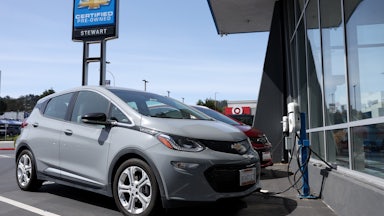Depending on the projection you favor, electric cars could account for anywhere from 10 percent to more than half of U.S. sales by 2030. Five years later, California will stop allowing the sale of new gas-powered cars altogether, and many states are expected to follow its lead. Meanwhile, President Biden—a self-described “car guy”—has pledged to electrify the American road trip and has posed for photos while test-driving electric models of a Ford F-150, a Cadillac Lyriq, a Jeep Wrangler, and a Hummer.
Excitement around all those shiny new electric vehicles, however, risks overshadowing one of our most promising emissions-cutting tools: public transportation.
Research has shown that Americans transitioning from trips in gas-powered cars to trains, buses, and other forms of mass transit is one of the most efficient ways to cut down on transportation emissions. But today, many public transit systems in the United States are struggling amid pandemic-dampened ridership that still hasn’t rebounded. In recent months, California’s Bay Area Rapid Transit has warned that it’s hanging over a “fiscal cliff,” even as climate experts call for more investment in trains and buses. And the E.V fervor has some transportation advocates worried that mass transit will get left even further behind.
As more Americans buy E.V.s, a quirk in the transportation financing system could create additional challenges. Transit agencies receive some funding from local and federal taxes on gasoline and diesel. Those already-dwindling revenues are set to fall further alongside the share of gas-powered cars.
“From a revenue point of view, it’s never really made sense to use proceeds of the gasoline tax to pay for people to stop driving and take mass transit instead,” said Jeff Davis, a senior fellow with the Eno Center for Transportation. “We’re starting to pay the price there, with … E.V. penetration here to where it’s starting to make a significant, measurable difference in gas tax receipts.”
Federal taxes collected on gasoline and diesel feed the Highway Trust Fund, a pot of money that’s divided between a highway account and a more modest mass transit account. Politically, raising the gas tax to put more money into this account has proved unpopular: The federal tax, currently at 18.4 cents a gallon, hasn’t increased since 1993, despite inflation. Though “gas-powered cars are still very much the norm,” said Aravind Boddupalli, a research associate at the Urban-Brookings Tax Policy Center, factors like inflation and increasing fuel efficiency are already depressing revenues.
Spending on highways has outpaced the Highway Trust Fund’s proceeds for years. And if investments in transit and roads keep pace with inflation and taxes remain stagnant, the Congressional Budget Office projects the gap will reach $189 billion by 2030. The rise in E.V.s further endangers the fund: The less people fuel up, the less tax collected. “The gap is already there,” said Davis—and it’s growing.
To keep the fund humming along, lawmakers have repeatedly infused it with one-time payments, most recently $118 billion included in the 2021 Infrastructure Investment and Jobs Act—but there’s no guarantee those occasional deposits will continue. Policymakers have advanced few long-term solutions that could help transit providers make up for the lost money.
Highways have historically received more from the Highway Trust Fund than transit. As the gap grows, roads may feel the first effects. For years, transportation experts and politicians have warned about the country’s deteriorating roadways amid the gas tax conundrum. In its most recent report on the state of U.S. highways, bridges, and transit, the Federal Highway Administration found that the overall condition of roads decreased from 2008 to 2010 (the report is from 2016). Roads in the U.S. received a “D” rating in a 2021 review from the American Society of Civil Engineers, a trade group.
Comparatively less attention has been paid to the potential impact to public transportation from a decrease in federal funds. And local transit could also suffer as E.V.s take off. Some states put all their collected gas tax funds toward maintaining roads, funding mass transit using local sales taxes or other revenue streams. In others, like California—the nation’s largest market for electric vehicles—about 80 percent of the sales tax on diesel fuel goes to public transit.
“It’s clear that the trajectory is that there will be less revenue for that important source of transit funding,” said John Gahbauer, a research consultant at the Institute of Transportation Studies at UCLA. “Something will have to change. What will that look like? We don’t know. And on what time frame? I don’t know.”
In the U.S., transit has historically received a fraction of the funding directed to roads and highways. That mismatch has helped fuel a car-dependent culture: In 2021 there were more than 279 million car registrations in the U.S., while about 183 million Americans took public transportation in the first week of March 2020, before the pandemic significantly changed ridership. Forty-five percent of Americans have no access to public transportation, according to the American Public Transportation Association, even though it’s often cheaper than owning a personal car.
Transportation accounts for the largest share of U.S. greenhouse gas emissions, and experts have urged policymakers to prioritize mass transit—often viewed as a public good—as well as promoting electric cars. Mass transit could also potentially avoid some of the negative elements of electrifying cars, like ballooning demand for lithium to build car batteries. Human rights organizations have documented violations associated with digging up the minerals needed for electric cars, and mining can also damage the environment. An analysis released this year found that reducing car dependency by encouraging the use of public transportation and walking or biking, while also reducing the size of E.V. batteries, could decrease projected U.S. lithium demand in 2050 by between 18 percent and 66 percent.
But public transit often remains inaccessible, in part because the U.S. has structured living and working around highways and car commutes. “A lot of policies continue to favor and indirectly subsidize car travel and car ownership,” said Gahbauer, who added that changing land use is a prerequisite for making public transit more usable for more people. Living within a mile of several neighborhoods with entertainment, jobs, and other services could save the average driver up to $1,200 in annual transportation costs and reduce emissions by between 2,455 pounds and 3,020 pounds of carbon dioxide—equivalent to the carbon sequestered by more than an acre of forest in a year—according to recent research from Brookings.
Before any future where transit flourishes, bus and rail companies must contend with present challenges. Overall ridership, and thus fare revenues, are still well below pre-pandemic levels in transit markets throughout the country. Though many passengers have returned, particularly to bus lines, the number of Americans riding public transit in late June was nearly 60 million lower than in early March 2020, according to data from the American Public Transportation Association. The federal government directed billions of dollars in support to keep transit systems afloat during the pandemic, but transit companies say those relief funds are likely to be tapped out in the next several years.
Amid those troubles, the gas tax suffers from a prioritization problem. Carter Rubin, senior transportation lead at the Natural Resources Defense Council, told me that serious consideration in Washington about what will become of the tax has felt forever stuck at “three to five years away.”
Some ideas to increase proceeds have been batted around. The NRDC proposes indexing the gas tax not only to inflation but also to total consumption. The Infrastructure Investment and Jobs Act directed the Transportation Department to assemble a board that will then create a national pilot to experiment with charging car owners based on how much they drive rather than how much gas they use. (DOT is more than a year behind on creating the board; a spokesperson from the Federal Highway Administration told The New Republic the agency was still preparing an official notice to seek nominations.)
More than 30 states have applied for their own federal funds or joined a state coalition to test out alternative funding mechanisms to replace the gas tax. But only a handful of states have actually started those pilots, and it’s unclear how much of that money states will funnel to transit.
Lawmakers could also decide to find a completely new revenue source for transit. But any solution will come down to political will, and Davis believes that “no one in Congress wants to deal with it.” That lack of urgency hasn’t changed, even as climate change accelerates.
“Transit is really essential to reaching our climate goals. It is, in a big way, the pillar of walkable, sustainable communities,” said Rubin. “So we need to do that at the same time that we electrify all the vehicles.”










